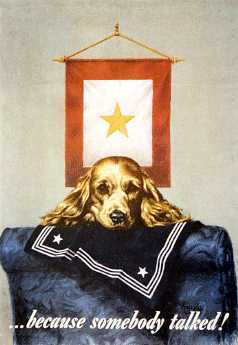


The Service Flag is an official banner authorized by the Department of Defense for display by families who have members serving in the Armed Forces during any period of war or hostilities the United States may be engaged in for the duration of such hostilities.
The history of the Service Flag is as patriotic and touching as the symbolism each star represents to the families that display them.
The service flag (also known as "blue star banners" or "son in service flags") was designed and patented by World War I Army Captain Robert L. Queissner of the 5th Ohio Infantry who had two sons serving on the front line. The flag quickly became the unofficial symbol of a child in service. President Wilson became part of its history when in 1918 he approved a suggestion made by the Women's Committee of the Council of National Defenses that mothers who had lost a child serving in the war to wear a gold gilt star on the traditional black mourning arm band.
This led to the tradition to cover the blue star with a gold star on the Service flag to indicate that the service member has died or been killed.
The color of the stars is also symbolic in that the blue star represents hope and pride and the gold star represents sacrifice to the cause of liberty and freedom.
During World War II, the practice of displaying the service flag became much more widespread. In 1942, the Blue Star Mothers of America was founded as a veteran service organization and was part of a movement to provide care packages to military members serving overseas and also provide assistance to families who encountered hardships as a result of their son or husband serving during the war.
Virtually every home and organization displayed banners to indicate the number of members of the family or organization serving in the Armed Forces, and again, covered those blue stars with a gold star to represent each member that died.
In 1960, Congress chartered the Blue Star Mothers of America as a veterans service organization and in 1966, the Department of Defense revised the specifications for the design, manufacture and display of the Service Flag.
The Department of Defense specifies that family members authorized to display the flag include the wife, husband, mother, father, stepfather, parent through adoption, foster parents who stand or stood in loco parentis, children, stepchildren, children through adoption, brothers, sisters, half brothers and half sisters of a member of the Armed Forces of the United States. The flag should be displayed in a window of the residence of person who are members of the immediate family.
The Service Flag may also be displayed by an organization to honor the members of that organization serving in the Armed Forces during a period of war or hostilities.
The Service Flag is an indoor flag and should be flown facing out from the front window of the home or organization.
If the U.S. flag is also displayed with the Service Flag, the U.S. flag should be of equal or greater proportions and should take the place of honor above the Service Flag.
If a gold star is added to the Service Flag, it should take the position of honor and be placed over the blue star that is positioned closest to the staff.
The gold star should be smaller than the blue star to create a blue border surrounding the gold star.
[ Historic Flags ]
[ History ]
[ Patriotic Writings ]
[ Miscellaneous ]
[ & Etcetera ]
[ Links to Web Sites of Special Interest]

 Home Page ]
[ Table of Contents ]
Home Page ]
[ Table of Contents ]
![]()